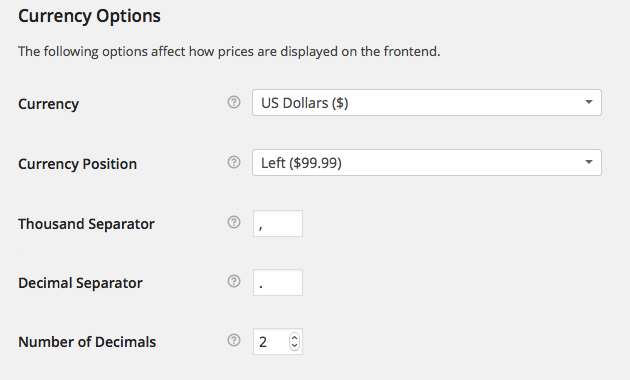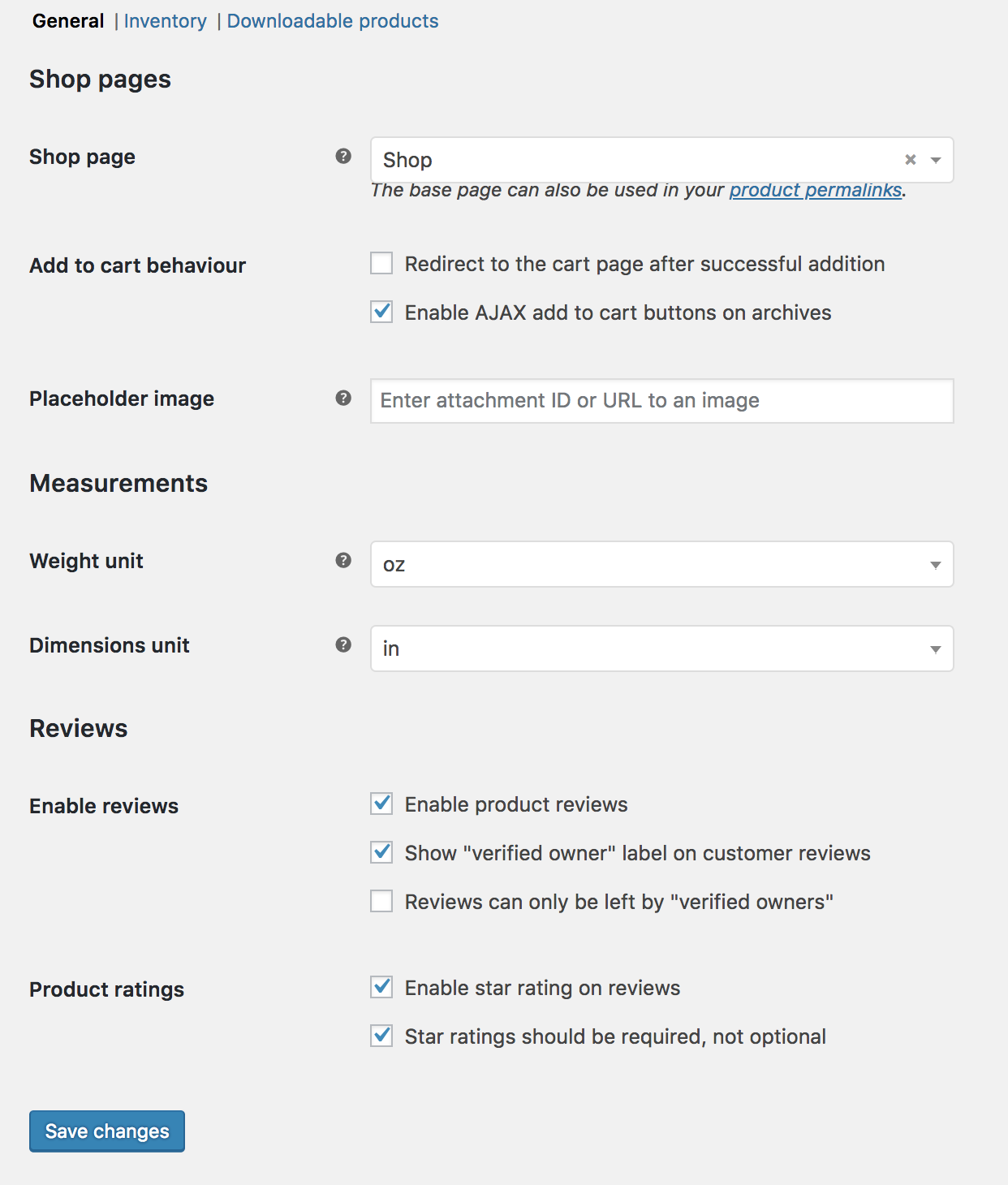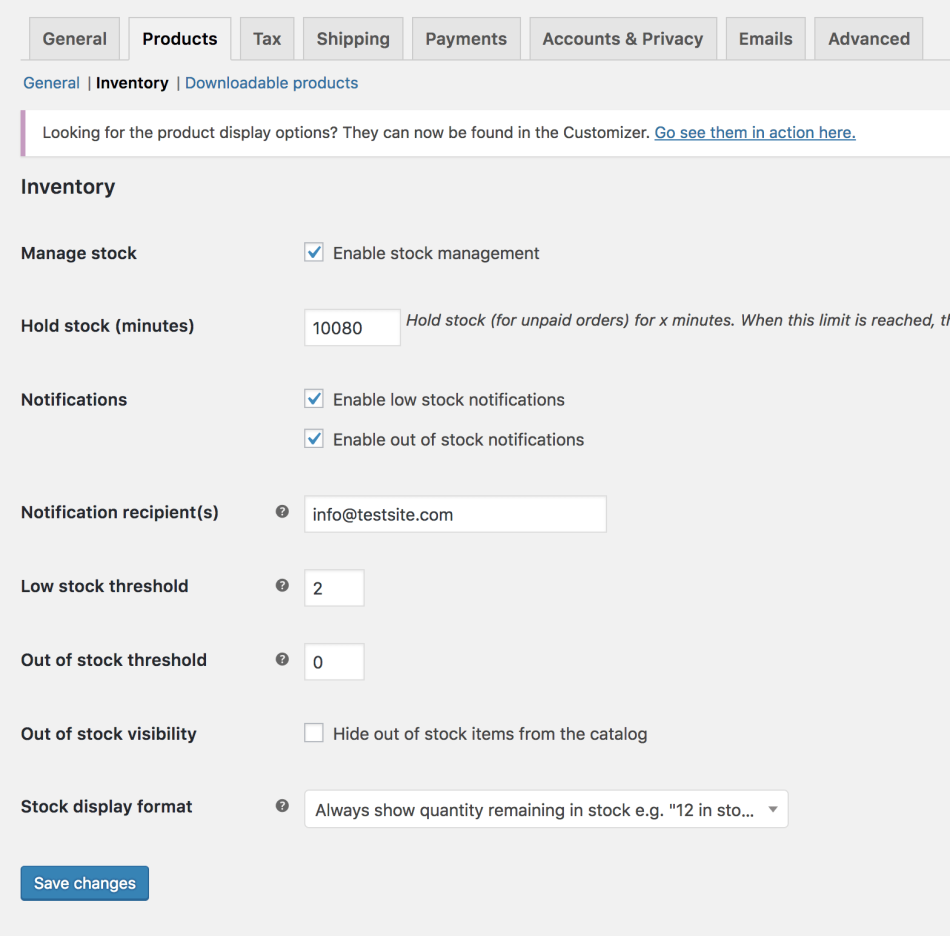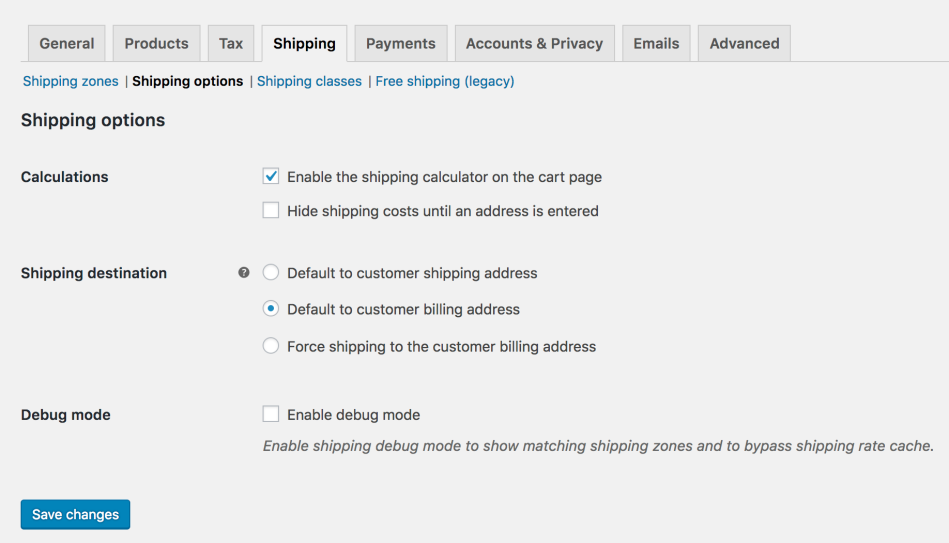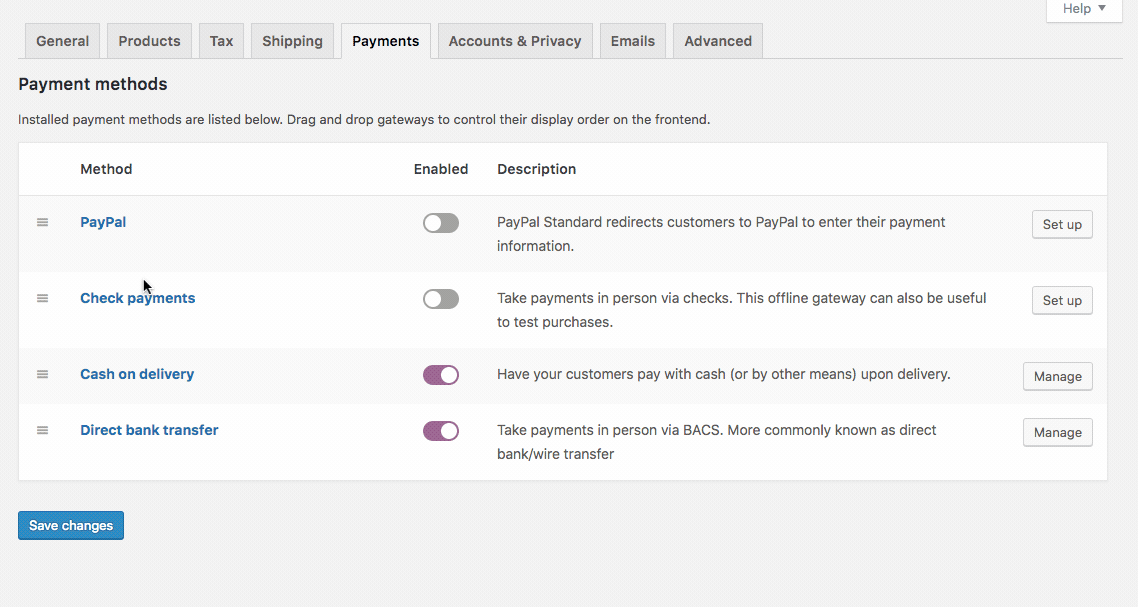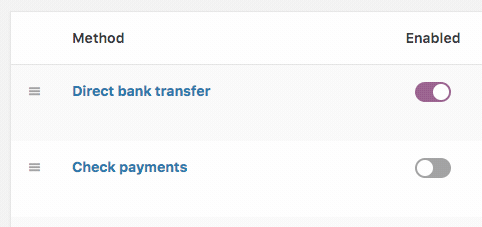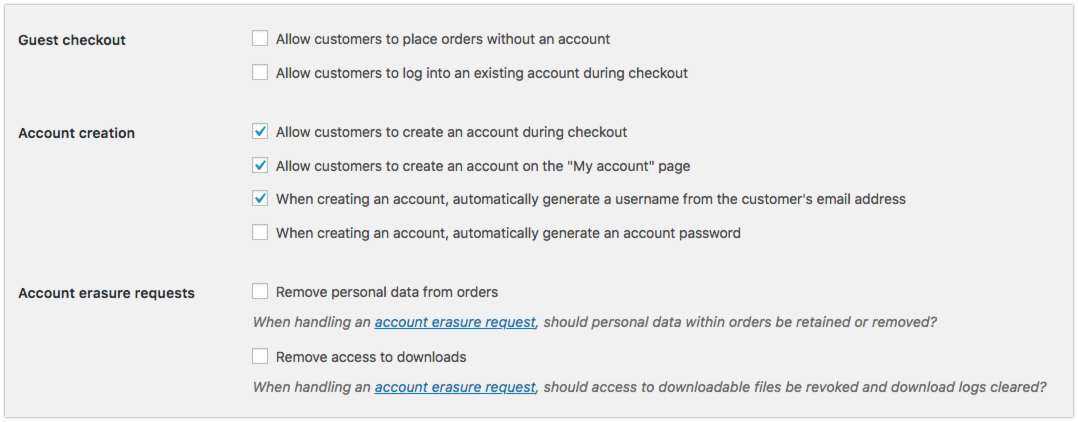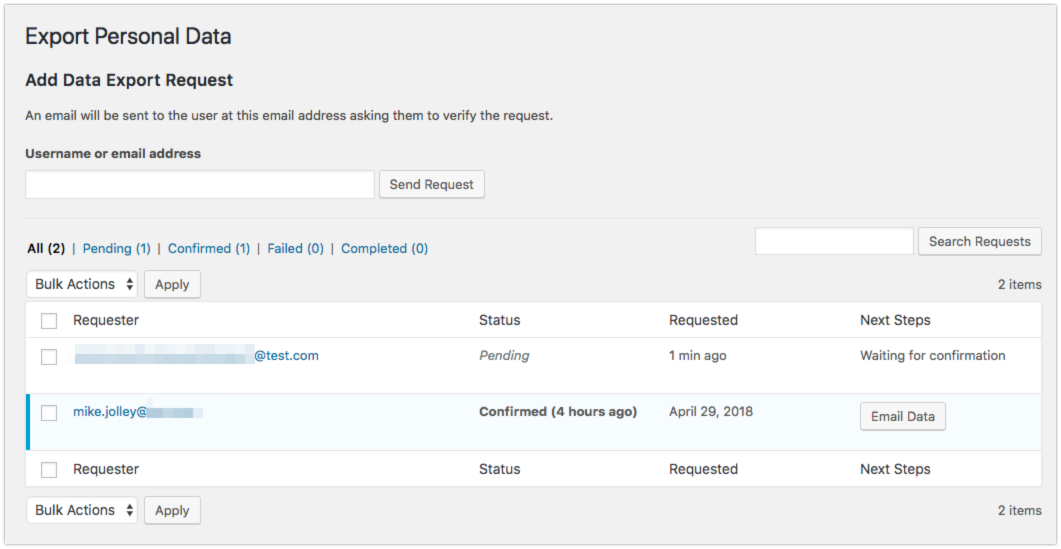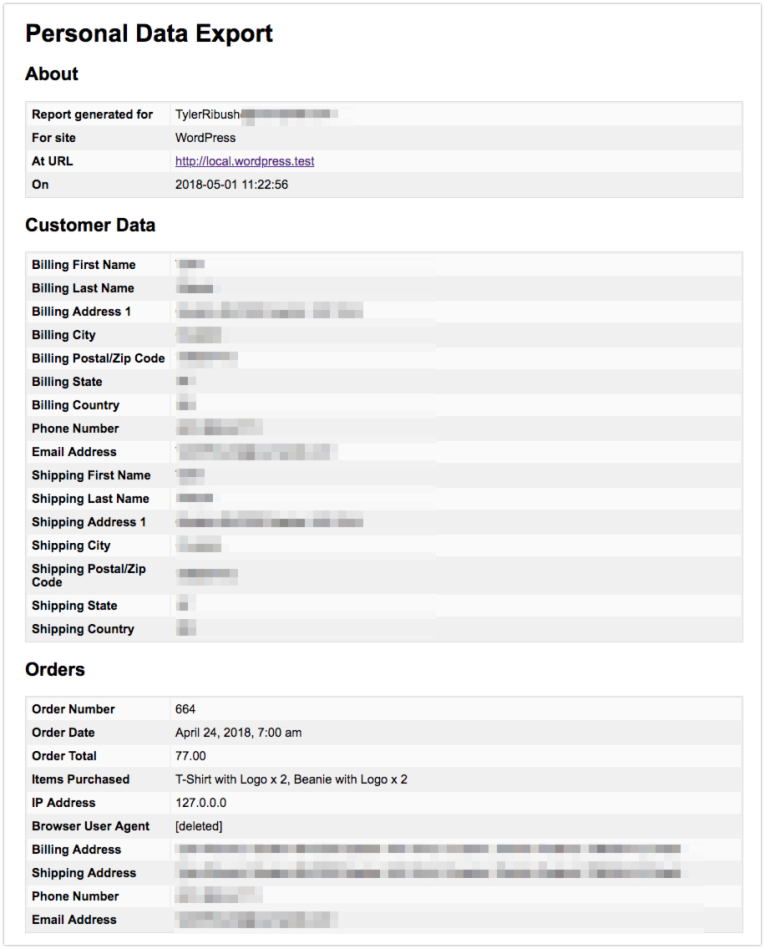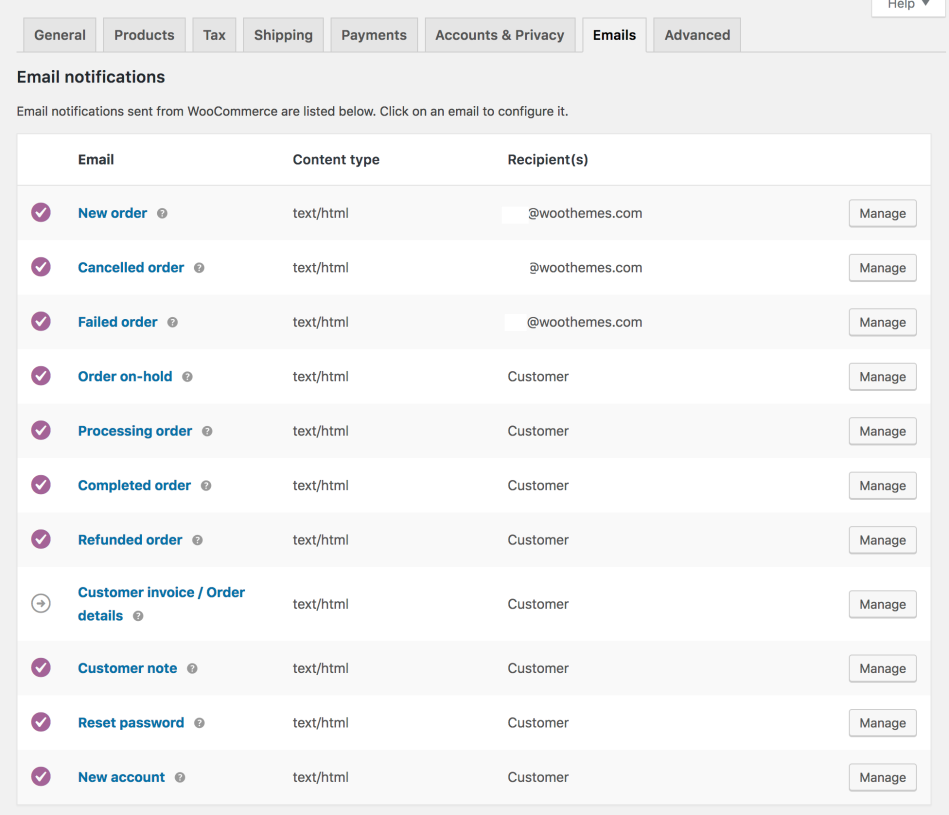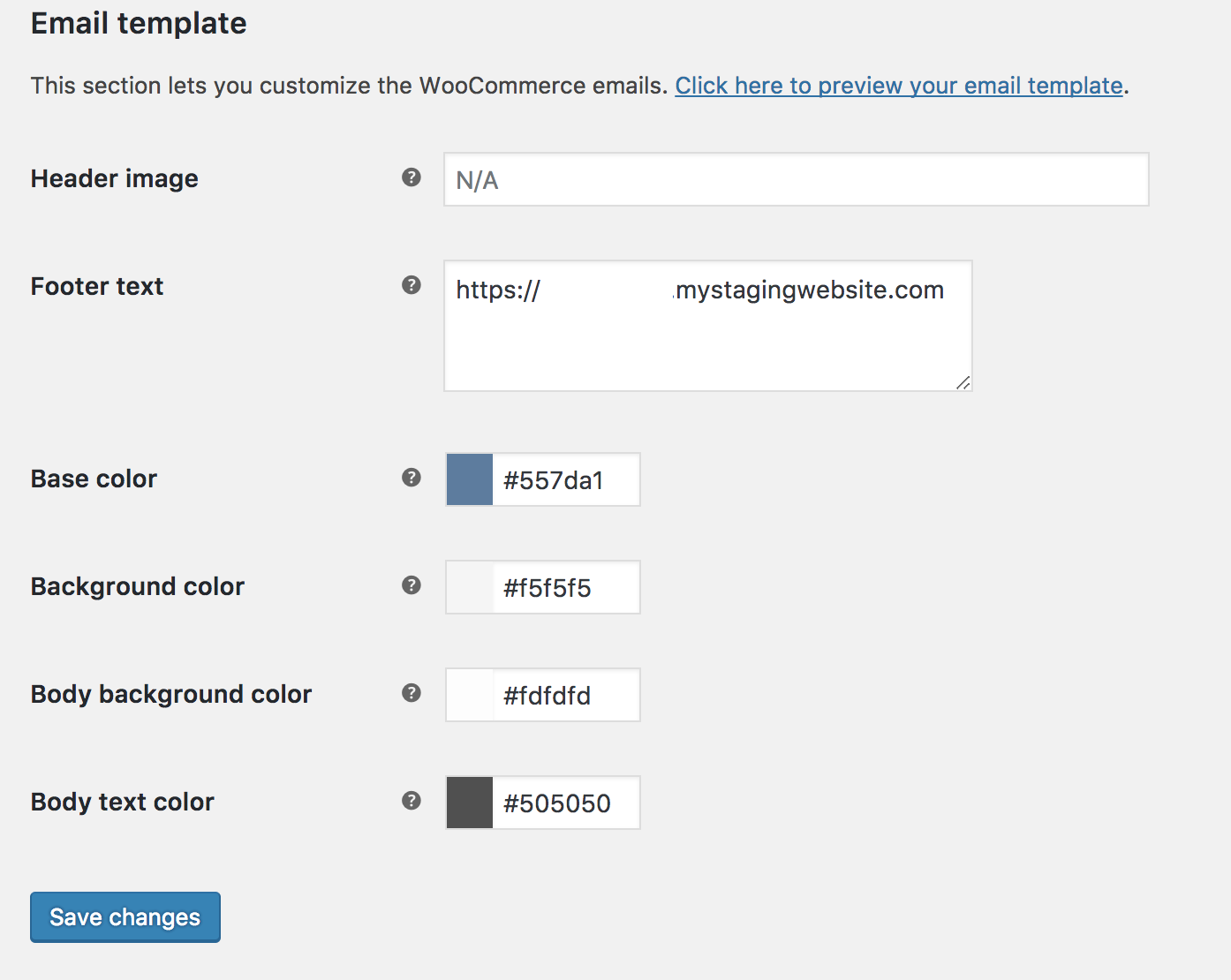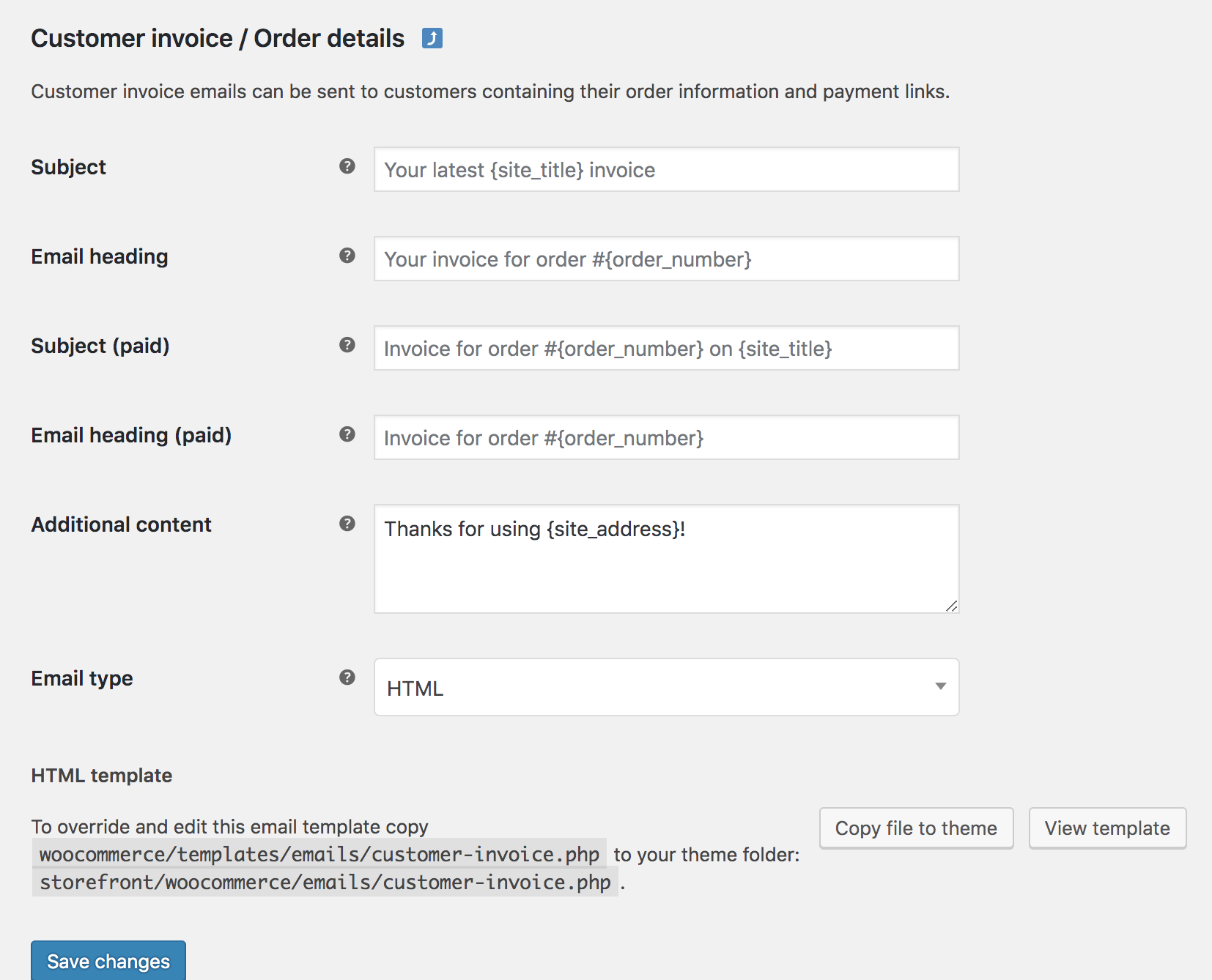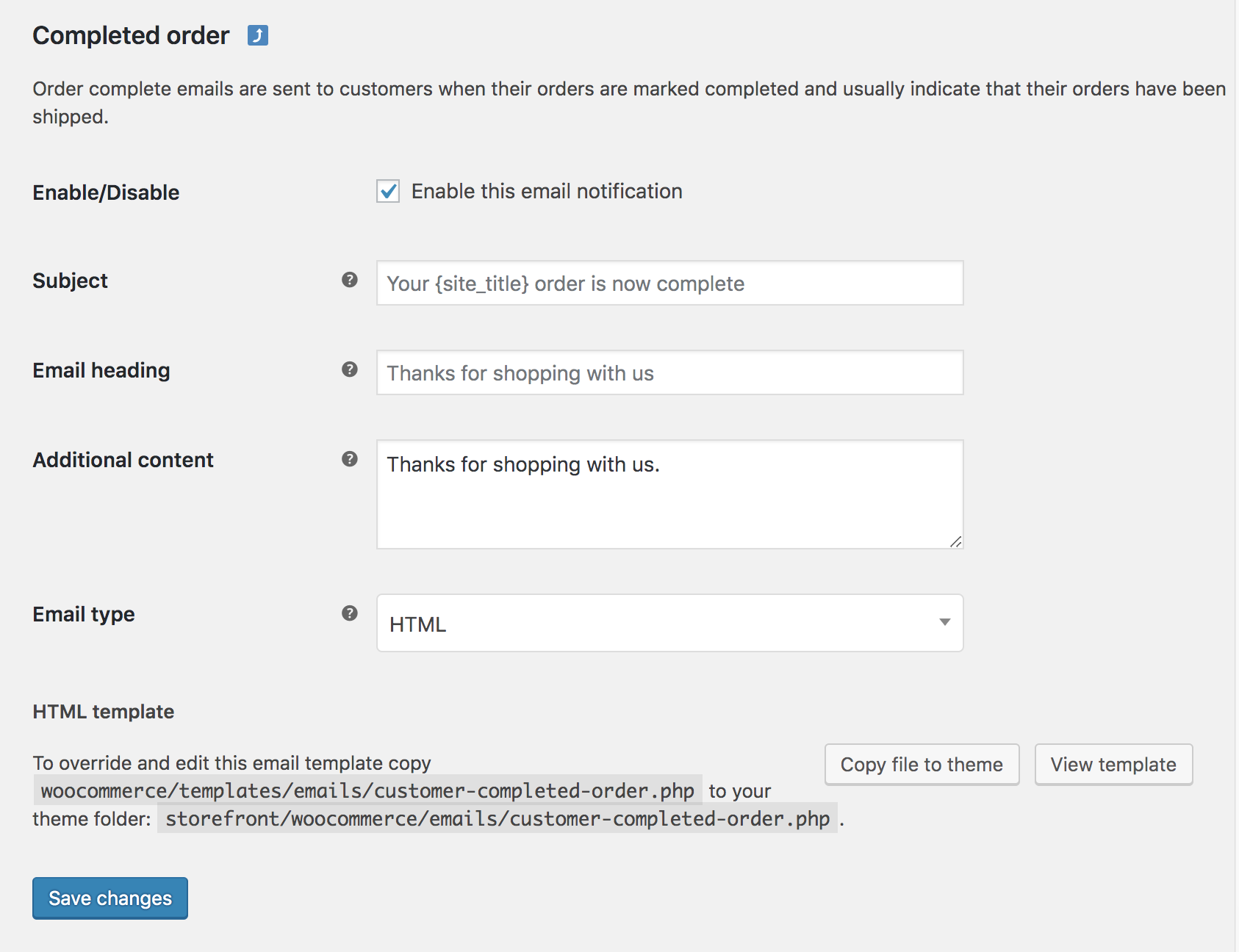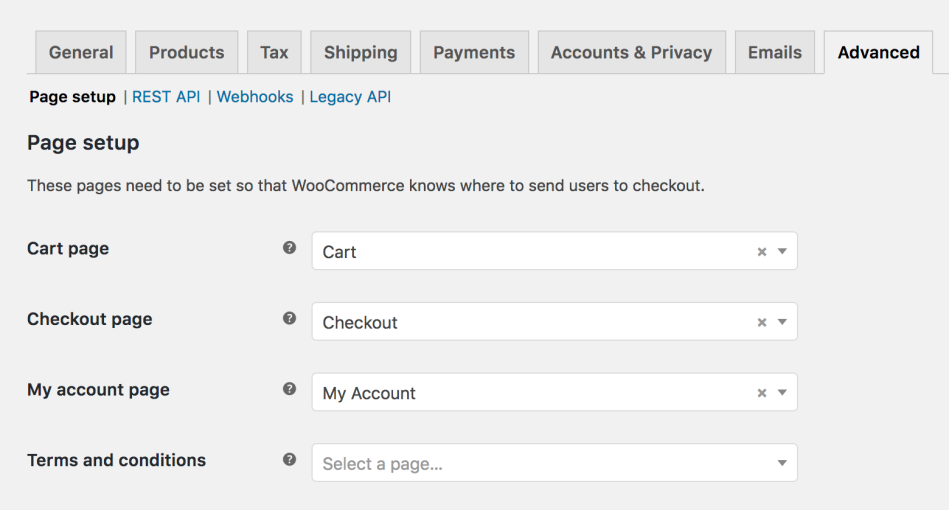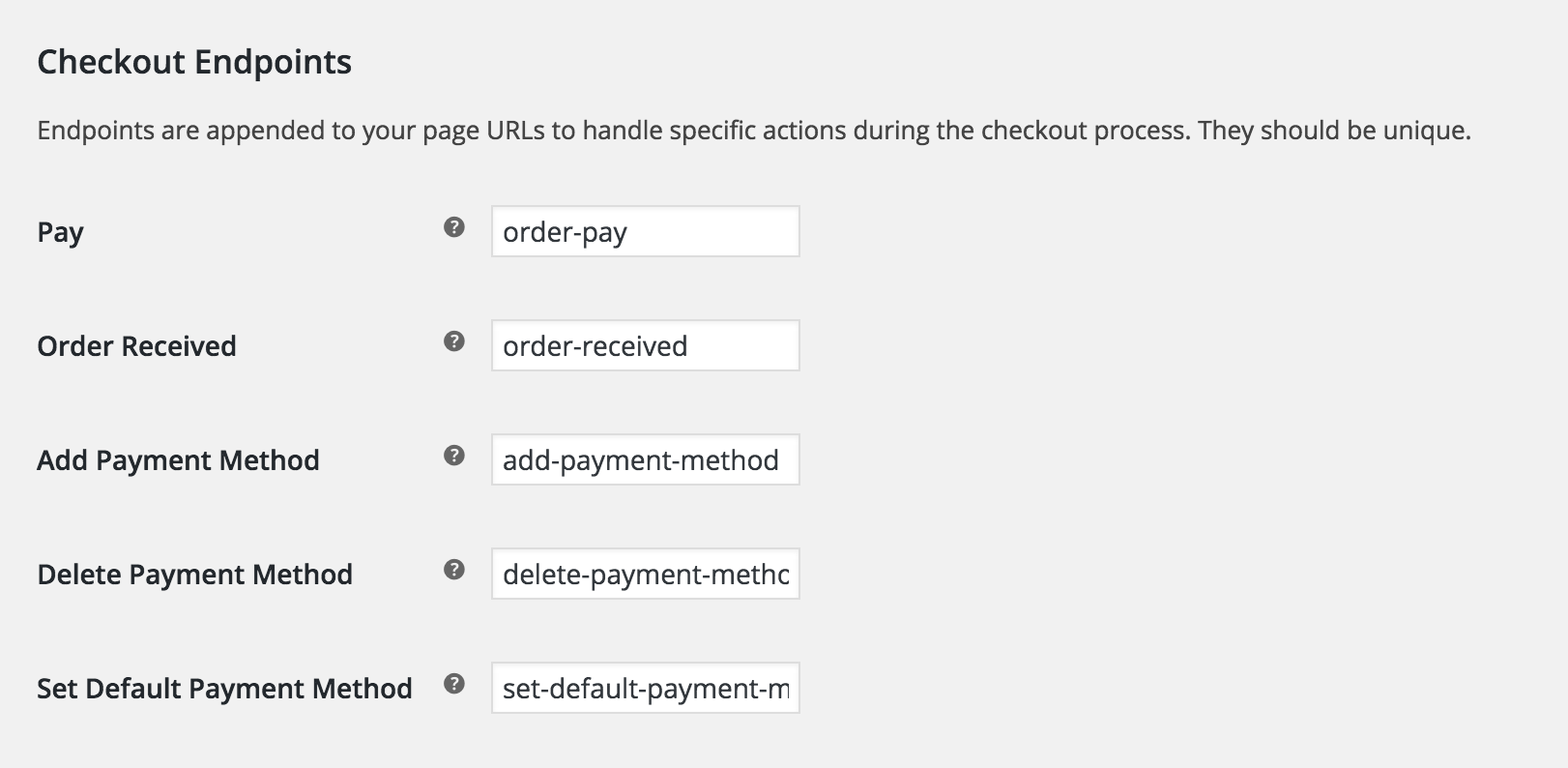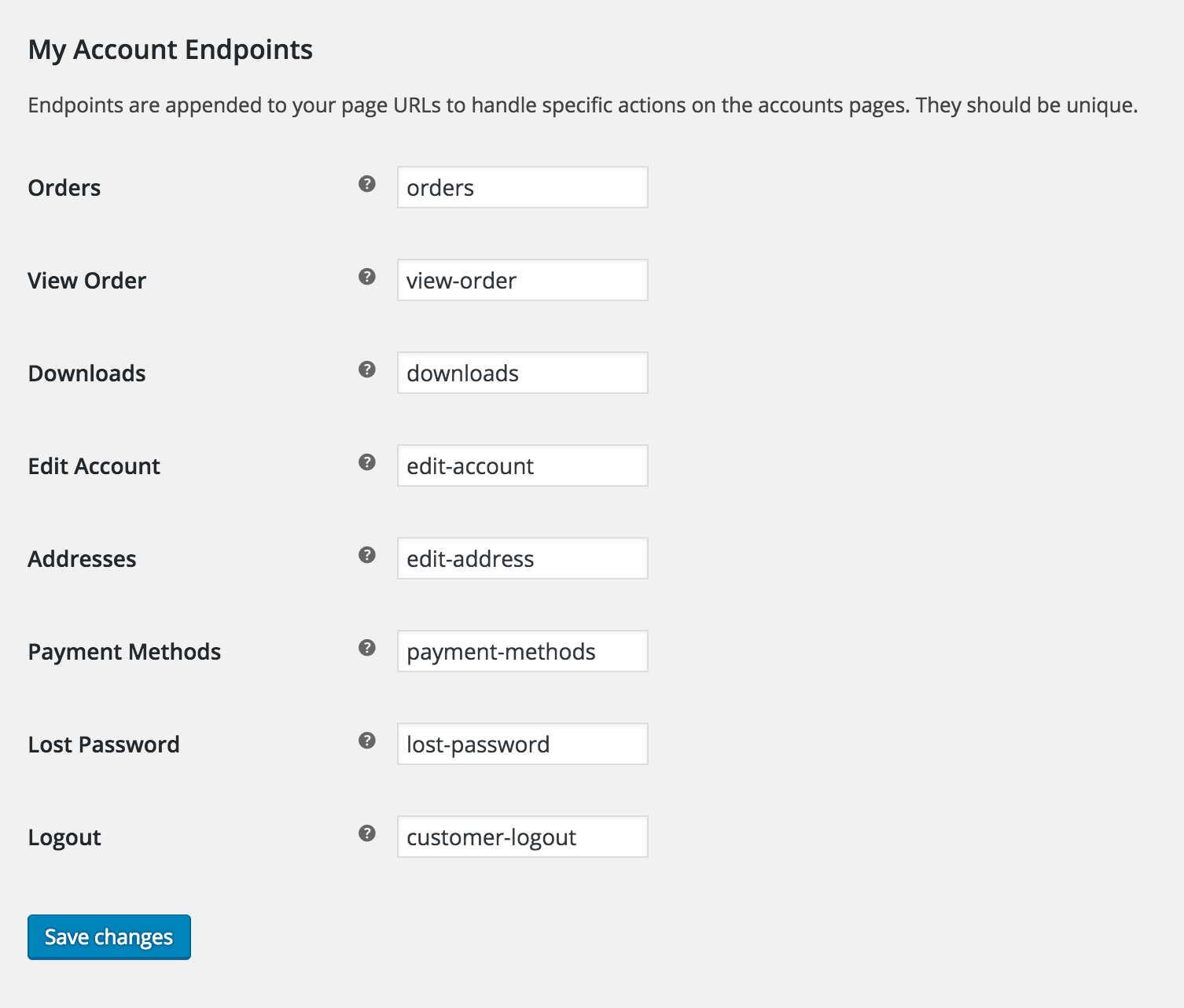Configuring WooCommerce Settings
On this page, we walk through all settings available to you in WooCommerce (some add-ons will embed their own settings in this area)
You’ll find information about configuring General WooCommerce settings as well as Product, Tax, Payments, Shipping, Accounts.

To get started, go to WooCommerce > Settings.
General Settings
Store address
Defines your shop’s address country and state, where you are based as a seller. It determines default tax rates and customer locations.
General options
Selling Location(s)
Choose to sell to all countries or to specific countries. You can choose multiple specific countries/regions.
Shipping Location(s)
Choose to ship to only those countries you sell to or a subset of countries. You can also disable shipping and all shipping-related functionality.
Default Customer Address
Choose the location we assume site visitors are in, before they enter it, to calculate tax and shipping.
- Shop base address tells the system to assume they are in the same location as your shop.
- No address gives them no location, so no taxes are calculated until they provide an address.
- Geolocate address verifies where their current location and calculate taxes accordingly.
- Geolocate with page caching support is the same as above, but does the geolocation via Ajax. You may notice your website URLs have a ?v=xxxxx appended to them. This is normal to prevent static caching of prices.
Enable Taxes
Enable or disable taxes on your store. Disabling taxes hides the tax settings page.
Enable coupons
Enable or disable coupons on your store. Coupons can be applied from the admin edit order screen (for unpaid orders), cart and checkout pages.
- Enable the use of coupon codes – Select to enable the use of coupons in your store.
- Calculate coupon discounts sequentially – Changes the coupon calculation logic to apply coupons in sequence on top of one another, rather than basing them on the original product prices.
Currency options
Options that affect how prices are displayed on the frontend.
Currency
Choose the default currency for the store. Only one may be selected.
Currency Position
Choose the default currency position for prices: Left, Right, Left/Right with space
Thousand Separator
Choose the symbol to use for the thousand separator: 1,000 or 1.000
Decimal Separator
Choose the symbol to use for the decimal separator: 100.00 or 100,00
Number of Decimals
Choose how many numbers to display to the right of the decimal when displaying prices: 100.00 or 100
Products Settings
Settings for products and how they are displayed, including image sizes, inventory and downloadable product settings.
General
In the General section are Shop Pages, Measurements and Reviews, allowing you to control checkout settings, select units of measurement, and enable/disable product reviews and ratings.
Go to: WooCommerce > Settings > Products > General:
Shop pages
Shop Page
Select what page you want to be the default shop page. Need not be the Shop page that WooCommerce installed, or can be skipped if you use another method to display products.
Add to cart behavior
- Redirect to cart page after successful addition – Automatically takes the customer to the cart page upon adding a product.
- Enable Ajax add to cart buttons on archives – Adds the ‘Add to Cart’ option to shop archive pages.
Placeholder Image
Set a default ‘placeholder’ image to appear on the front end when no other image is available. This could be your brand logo or an image of a signature product or service.
Measurements
Select a unit of measurement for weight and dimension of products from the dropdown.
Reviews
Enable Reviews
- Enable product reviews
- Select whether to display if the reviewer bought the product
- Control if anyone can leave a review or only buyers
Product Ratings
- Enable stars on reviews.
- Select whether it’s required or optional
Inventory Options
To edit your shop’s inventory options, go to: WooCommerce > Settings > Products > Inventory.
Choose whether to enable stock management. If selected, you have these options:
- Manage stock
- Enable stock management – Inventory for physical products is auto-managed. You enter quantity, and WooCommerce subtracts items as sales are made, displaying: Stock, Out of Stock or On Backorder.
- Disable (box left unticked) – Inventory and status for physical products must be entered manually. You can still Enable Stock Management on a per-product level if desired.
- Hold Stock (minutes) – Hold products (for unpaid orders) for X minutes. When the limit is reached, the pending order is cancelled. Leave blank to disable. Please note that this will work for orders in the “Pending payment” status, but not “On hold”.
- Notifications
- Enable low stock notifications
- Enable out of stock notifications
- Notification Recipient – Enter the email address for notifications.
- Low Stock Threshold – Number of products to trigger low stock notification
- Out Of Stock Threshold – Number of products to trigger out of stock status.
- Out Of Stock Visibility – Choose to hide out of stock items from catalogue.
- Stock Display Format
- Always show stock – “12 in stock”
- Only show stock when low – “Only 2 left in stock” vs. “In stock”
- Never show amount
Downloadable Products
Go to: WooCommerce > Settings > Products > Downloadable products.
File Download Method
Controls how your store provides downloadable files to purchasers.
- Force Downloads – Files are ‘forced’ to download via a PHP script. Files are not accessible to anyone but purchasers, and direct links are hidden.
- X-Accel-Redirect/X-Sendfile – Similar to ‘forced’ above, but it has better performance and can support larger files. It requires that your hosting provider supports either X-Sendfile or X-Accel-Redirect, so you need to check with them first.
- Redirect only – A download URL links the user to the file. Files are not protected from outside access.
Most stores should use one of the first two methods to keep files safe from outside access. Redirect should only be used if you encounter problems or don’t mind downloads being non-secure.
Access Restriction
- Select if downloads require a login – This does not apply to guest purchases.
- Grant access to downloadable products after payment – Enable to grant access to downloads when orders are Processing, rather than Completed.
Tax Settings
Go to: WooCommerce > Settings > Tax.
Shipping Settings
Go to: WooCommerce > Settings > Shipping.
Shipping Zones
The main shipping settings screen is for Shipping Zones. Think of a shipping zone as a geographic region where a certain set of shipping methods and their rates apply.
You can read about setting up shipping zones at: Setting up Shipping Zones
Shipping Options
Calculations
- Enable the shipping calculator on the cart page
- Hide shipping costs until an address is entered
Shipping Destination
Ship to billing address or customer shipping address by default or only ship to the user’s billing address.
Debug Mode
Enable for troubleshooting purposes.
Payments Settings
Go to: WooCommerce > Settings > Payments to control which payment gateways are enabled.
Installed gateways are listed and can be dragged and dropped to control the order in which they display to customers on the checkout.
Clicking the name of the payment gateway will take you directly to a screen to set up or adjust your settings.
Another way to configure settings is to select Set Up or Manage. You can also use the Enabled toggle to turn a gateway on or off:
If you try to enable a payment method that needs extra configuration, it will redirect you to the payment methods setup screen.
Accounts and Privacy Settings
Go to WooCommerce > Settings > Accounts and Privacy to control options relating to customer accounts and data retention.
Guest Checkout
- Allow customers to place orders without an account – Allows customers to check out without creating an account. Orders will not be tied to a user account in WordPress.
- Allow customers to log into an existing account during checkout – This displays a login form and prompt on the checkout page if the customer is not already logged in.
Account Creation
- Allow customers to create an account during checkout
- Allow customers to create an account on the My account page
- Automatically generate username from customer email – If this is disabled, there will be an input box for the user to create their own username.
- Automatically generate customer password – If this is disabled, there will be an input box for the user to set their own password. Note that while the password strength notification will be displayed at Checkout, customers can choose any password so as to not limit conversions. On the My Account page, the password will need to meet certain complexity requirements (i.e. a combination of the number of characters and mixture of uppercase / lowercase / numeric / symbol characters).
Account erasure requests
- Remove personal data from orders – WordPress 4.9 allows you to remove personal data on request. When doing this, if you enable this option, user data will also be removed from your orders if they belong to the user being erased.
- Remove access to downloads – WordPress 4.9 allows you to remove personal data on request. When doing this, if you enable this option, download data will also be removed if it belongs to the user being erased. The erased user will no longer have access to any purchased downloads if this happens.
Personal data removal
- Allow personal data to be removed in bulk from orders – Adds a new bulk action to remove personal data on the Orders page. Useful if you need to manually anonymize orders in bulk.
Privacy policy
This section lets you select a page for your privacy policy, and display privacy policy snippets on your account and checkout pages shown to customers.
- Privacy Page – Select a page to act as your privacy policy. Using [privacy_policy] will link to this page. Some themes also use this option to link to a privacy policy in other places, such as the footer. This feature was added in WordPress 4.9.
- Registration privacy policy – Shown on the registration form on the My Account page. You should include information about your privacy policy, and link to your page privacy policy page for more information.
- Checkout privacy policy – Shown on the checkout form. You should include information about your privacy policy, and link to your page privacy policy page for more information.
Personal data retention
This section allows you decide how long to keep order data on your store. You should specify how long your site will retain data in your privacy policy; consider what makes sense for local laws such as the EU GDPR.
For each option, enter a number and choose the duration from days, weeks, months, or years. Leaving these options blank will disable them.
- Retain inactive accounts – Inactive accounts are accounts that have not logged in nor placed an order for the specified duration.
- Retain pending orders – Pending orders are unpaid or abandoned and should not need to be fulfilled.
- Retain failed orders – Failed orders are unpaid or abandoned and should not need to be fulfilled.
- Retain cancelled orders – Cancelled orders were orders cancelled on purpose by either the admin or the customer, or timed out waiting for payment.
- Retain completed orders – Completed orders were fulfilled in the past.
Personal Data Exporter
WordPress 4.9.6 has the ability to export personal data associated with an email address to an HTML file. WooCommerce adds to the generated export file, exporting the following data:
- Customer address/account information
- Orders associated with the given email address
- Download permissions and logs associated with the given email address
To ensure requests are genuine, a confirmation email is sent to verify the request. The verification process:
- Enter an email address or username.
- User is notified via email with a confirmation link.
- Confirmation link is used, and request is marked “confirmed.”
- Email with link to download their personal data is sent to the user.
Example of a Personal Data File:
Email Settings
Options available to edit email settings and templates.
Go to: WooCommerce > Settings > Emails.
Email notifications
For each WooCommerce email listed, it’s possible to configure your settings (optional). More detailed instructions below in: Editing Individual Email Templates.
Email Sender Options
Set the ‘From’ name and email address for the sender.
Email Templates
This section lets you customise WooCommerce emails.
Header Image
Enter the URL of an image you want to show in the email header. You can upload an image via the Add Media button or Media > Add New.
Email and Text
- Base Color – Color for WooCommerce email templates.
- Background Color – Background color for WooCommerce email templates.
- Email Body Background Color – Main body background color.
- Email Body Text Color – Main body text color.
Editing Individual Email Templates
In the list above in Email Notifications are these templates:
New order | Cancelled order | Failed order | Processing order | Completed order | Refunded order | Customer invoice | Customer note | Reset password | New account
Select Manage on the right side, and a new screen appears.
New order
Select options or enter preferences:
Enable/Disable
Enable this email notification.
Recipient(s)
Enter recipients (comma separated) for this email.
Subject
This controls the email subject line. Leave blank to use the default subject:
[{site_title}] New customer order ({order_number}) - {order_date}
Email Heading
This controls the main heading contained within the email notification. Leave blank to use the default heading.
Email type
Choose which format of email to send. Options include:
- Plain Text
- HTML
- Multipart
If using Plain Text emails, keep in mind that text fields are limited to 155 characters. If your products have long names and/or numerous variations/add-ons, the field may be truncated.
Save any changes.
Completed order and Customer invoice / order details
The Completed order and Customer invoice/ Order details templates have slightly different settings from others.
- Customer invoice/Order details cannot (and should not) be disabled.
- Both templates have ‘Thanks’ fields that can be altered.
Advanced Settings
Advanced settings allow you to change WooCommerce defaults and integrate with the API. Go to: WooCommerce > Settings > Advanced.
Page Setup
Pages need to be set so WooCommerce knows where to send users to perform certain actions:
- Cart Page – This page shows items in your customers cart.
- Checkout Page – This page is where your customer will enter their payment information and submit orders.
- My Account page – This page is where registered customers will go to view their orders or update their account details.
- Terms and Conditions – This page shows terms and conditions.
- Secure checkout – Force SSL (HTTPS) on the checkout pages. An SSL Certificate is required, if selected.
You need not use the pages WooCommerce installed, but you must have a page set for the Cart and Checkout pages. Otherwise your customers cannot buy and pay for your products. These pages are normally created and set when installing/setting up WooCommerce.
To use a Terms and Conditions page, create a new page for it at Pages > Add New, then select the page in the dropdown. The Terms and Conditions appear inline during checkout, and the customer can scroll through content and tick the checkbox to accept.
Checkout Endpoints
Endpoints are appended to page URLs to handle specific actions during the checkout process. They should be unique.
My Account Endpoints
Endpoints are appended to your page URLs to handle specific actions on the accounts pages. They should be unique.
- Orders
- View Order
- Downloads
- Edit Account
- Addresses
- Payment Methods
- Lost Password
- Logout
Related Articles
Woocommerce Emails
Email Settings Options available to edit email settings and templates. Go to: WooCommerce > Settings > Emails. Email notifications For each WooCommerce email listed, it’s possible to configure your settings (optional). More detailed instructions ...Woocommerce Refunds
Summary In WooCommerce itself you can process refunds in two ways: Automatic: Refunds change the WooCommerce order status and also reverse the charge so your customer gets their money. Manual: Refunds change the WooCommerce order status, but you need ...WooCommerce Menu Items
Home Section The Home section is your WooCommerce dashboard. Here you can stay on top of your store performance, get useful tips and insights to grow your business, and quickly access some of the most important areas to manage your store. More ...Woocommerce Home Screen
Home Screen In WooCommerce Home you can stay on top of your store performance, get useful tips and insights to grow your business, and quickly access some of the most important areas to manage your store. Display Settings In the Activity Panel area ...Cash On Delivery - Woocommerce
Cash on Delivery (COD) is a payment gateway that required no payment to be made online. Orders using Cash on Delivery are set to Processing until payment is made upon delivery of the order by you or your shipping method. You, as the store owner, need ...
